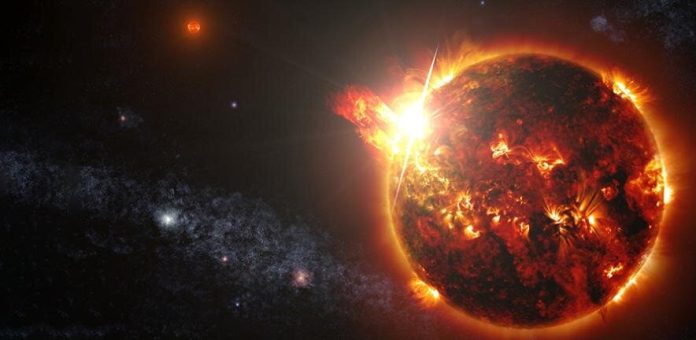
Astronomers have found that red dwarf stars, which are common in our galaxy, can produce stellar flares with far-ultraviolet (far-UV) radiation levels much higher than previously thought.
This discovery suggests that these intense UV flares could significantly affect the habitability of planets orbiting these stars.
“Few stars have been thought to generate enough UV radiation through flares to impact planet habitability.
Our findings show that many more stars may have this capability,” said Vera Berger, the study’s lead author.
Berger conducted the research at the University of Hawai’i and is now at the University of Cambridge.
The research team used data from the GALEX space telescope, which operated from 2003 to 2013, to search for flares among 300,000 nearby stars. GALEX observed most of the sky at near- and far-UV wavelengths. By applying modern computational techniques, the team analyzed the data to uncover new insights.
“Combining modern computer power with gigabytes of decades-old observations allowed us to search for flares on thousands and thousands of nearby stars,” explained co-author Dr. Michael Tucker from Ohio State University.
UV radiation from stellar flares can have significant effects on planets. It can erode planetary atmospheres, making them less capable of supporting life, or it can contribute to the formation of essential life-building molecules like RNA.
The study, published in the Monthly Notices of the Royal Astronomical Society, challenges existing models of stellar flares and planet habitability. It shows that far-UV emission from flares is, on average, three times more energetic than previously assumed, and can reach up to twelve times the expected energy levels.
“A change of three is the same as the difference in UV in the summer from Anchorage, Alaska to Honolulu, where unprotected skin can get a sunburn in less than 10 minutes,” said co-author Benjamin J. Shappee from the University of Hawai’i.
What’s causing the stronger emissions?
The exact cause of the stronger far-UV emission remains unclear. The team believes that flare radiation might be concentrated at specific wavelengths, suggesting the presence of atoms like carbon and nitrogen.
“This study has changed the picture of the environments around stars less massive than our sun, which emit very little UV light outside of flares,” said co-author Jason Hinkle.
According to Berger, more data from space telescopes is needed to study UV light from stars, which is crucial for understanding the source of this emission.
“Our work puts a spotlight on the need for further exploration into the effects of stellar flares on exoplanetary environments,” said Berger. “Using space telescopes to obtain UV spectra of stars will be crucial for better understanding the origins of this emission.”
In conclusion, this research highlights the potential risks posed by stellar flares to planets that could host life, emphasizing the need for further study to better understand these cosmic events and their impact on planetary environments.



